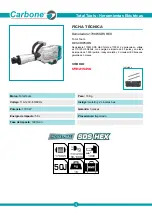
shown in the figure) in such a manner that the lateral open-
ings on the extraction outlet remain free. This prevents the
power tool from adhering to the workpiece during sanding
and the surface quality of the workpiece from being im-
paired.
Connect the dust extraction hose
(23)
to an extractor. You
will find an overview of connecting to various dust extractors
at the end of these operating instructions.
The dust extractor must be suitable for the material being
worked.
When extracting dry dust that is especially detrimental to
health or carcinogenic, use a special dust extractor.
When working on vertical surfaces, hold the power tool with
the dust extraction hose facing downwards.
Changing the sanding sheet
Remove dirt and dust from the sanding plate
(10)
, e.g. with
a brush, before attaching a new sanding sheet.
To ensure optimum dust extraction, make sure that the
punched holes in the sanding sheet are aligned with the
drilled holes in the sanding plate.
Sanding sheets with hook-and-loop backing
(see figure E)
The sanding plate
(10)
is fitted with a hook-and-loop fasten-
ing, allowing sanding sheets with a similar backing to be se-
cured quickly and easily.
Tap the hook-and-loop fastening of the sanding plate
(10)
before fitting the sanding sheet
(14)
to facilitate maximum
adhesion.
Position the sanding sheet
(14)
so that it is flush with one
side of the sanding plate
(10)
, then place the sanding sheet
on the sanding plate and press it on firmly.
To remove the sanding sheet
(14)
, take hold of it by a corner
and pull it away from the sanding plate
(10)
.
Sanding sheets without hook-and-loop backing
(see figures A–B)
Push the clamping lever
(9)
down.
Slide the sanding sheet
(14)
under the open front clamping
bracket
(8)
as far as possible and let go of the clamping lever
(9)
.
Open the clamping lever
(11)
.
Position the sanding sheet
(14)
so that it fits tightly around
the sanding plate. Slide the other end of the sanding sheet
(14)
under the open front clamping bracket
(12)
and clamp
the sanding sheet in place by closing the clamping lever
(11)
.
Unperforated sanding sheets, e.g. from rolls or bulk stock
sold by the metre, can be perforated using the punch
(15)
for the purpose of dust extraction. To do this, fit the sanding
sheet on the power tool and push the tool down onto the
punch (see figure
D
).
To remove the sanding sheet
(14)
, open the clamping lever
(11)
and push the clamping lever
(9)
down. Pull the sanding
sheet out.
Choosing the sanding sheet
Different sanding sheets are available, depending on the ma-
terial you are working with and the required surface removal
rate:
Grit
For processing all wood and wood-based ma-
terials
40 – 400
For pre-sanding, e.g. of rough and un-
even beams and boards
Coarse 40, 60
For surface sanding and levelling of
slight irregularities
Medium 80, 100,
120
For finish-sanding and fine sanding of
hardwoods
Fine
180, 240,
320, 400
For processing paint and lacquer layers or
primers such as fillers and bodyfillers
40–320
For sanding down paint
Coarse 40, 60
For sanding undercoats
Medium 80, 100,
120
For final sanding of primers prior to
painting
Fine
180, 240,
320
Note:
To avoid the sanding sheet tearing, only use sanding
sheets with a grit of 80 or above.
Changing the sanding plate (see figure F)
If necessary, the sanding plate
(10)
can be replaced.
Unscrew the six screws
(16)
completely and remove the
sanding plate
(10)
. Fit the new sanding plate
(10)
and
retighten the screws.
Special Sanding Plates
You can replace the standard supplied sanding plate
(10)
with one of the special sanding plates that are available as
accessories.
Special sanding plates are fitted in exactly the same way as
the standard supplied sanding plate.
Likewise, each sanding sheet is attached and removed in ex-
actly the same way as the original sanding sheet.
Elongated sanding plate, triangular, thin (see figure G)
Using the triangular, thin, elongated sanding plate
(17)
en-
ables you to sand difficult-to-reach places and tight spaces
such as window and door posts, grooves, or behind radiat-
ors and water pipes.
To fit the triangular, thin, elongated sanding plate
(17)
, use
the screws designed for this purpose
(19)
.
Elongated sanding plate, triangular (see figure H)
Using the triangular, elongated sanding plate
(21)
enables
you to sand edges and corners.
English |
15
Bosch Power Tools
1 609 92A 4J9 | (17.07.2018)
Содержание GSS 230 AVE
Страница 4: ...4 1 609 92A 4J9 17 07 2018 Bosch Power Tools 15 10 14 16 10 17 18 19 20 21 20 14 16 C D E F G H ...
Страница 5: ... 5 Bosch Power Tools 1 609 92A 4J9 17 07 2018 2 1 2 1 7 7 6 6 22 23 22 I J K L M N ...
Страница 183: ... آفارسی 183 Bosch Power Tools 1 609 92A 4J9 17 07 2018 ...
Страница 186: ...186 1 609 92A 4J9 17 07 2018 Bosch Power Tools ...
















































